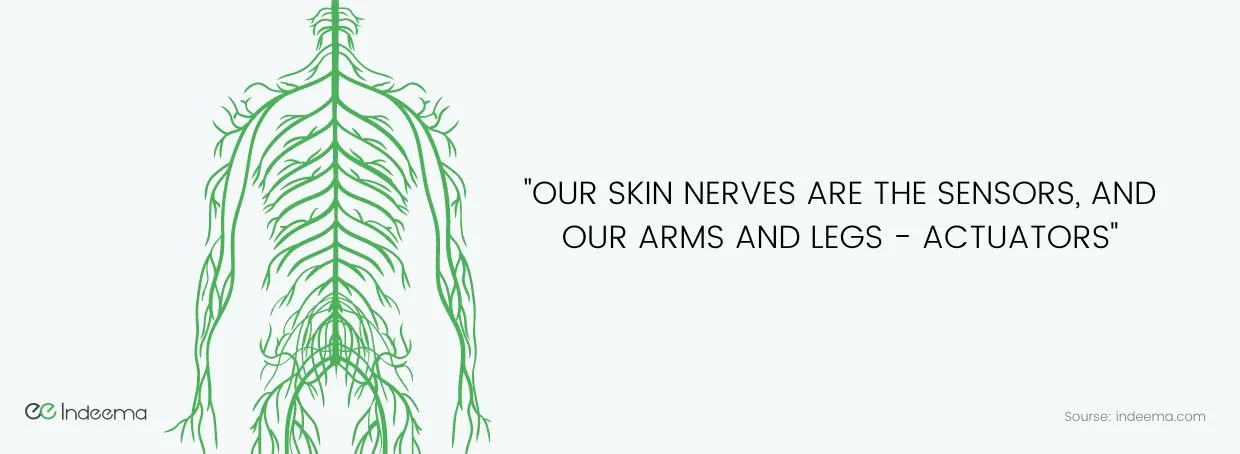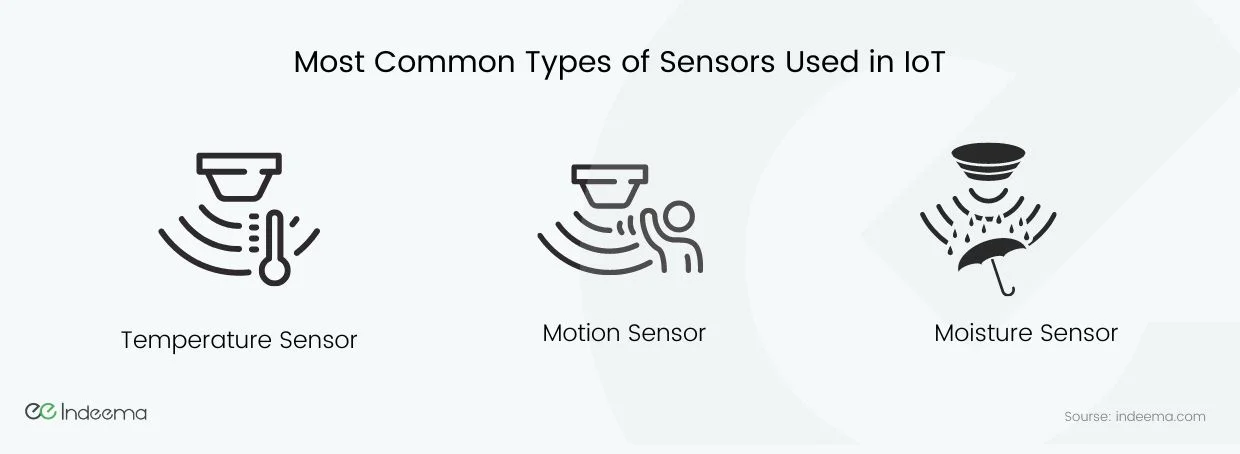Introduction
The Internet of Things is often referred to as the Internet of People because IoT device networks operate similarly to the human nervous system.
Just like nerves sense external events and relay information to the brain, IoT devices perceive data through sensors and transmit it to control centers for processing. This process is akin to how our bodies respond to stimuli.
For instance, if you accidentally burn your hand while cooking, your skin nerves detect the heat and swiftly alert your brain, prompting an immediate reaction to remove your hand from the heat source and immerse it in cold water. In this article, we will delve further into the parallels between IoT devices and the human nervous system, exploring the functions of sensors, control centers, and actuators.

1. The IoT Digital Nervous System: How It’s Built
Imagine your hand being burned. Not a good feeling, but allow us to draw a comparison for a moment. The skin nerves can be compared to sensors, the brain to the control system, and the limbs and body movements that direct an arm away from danger can be compared to actuators.
Similarly, IoT devices function in a similar manner to human bodies, replacing nerves and the brain with sensors, actuators, and on-premises/cloud control centers. These components work in unison to ensure that IoT devices and networks respond to programmed actions and provide prompt and appropriate reactions. It's truly a captivating concept, isn't it? In this article, we will delve into the world of Internet of Things devices and explore the use of sensors and actuators in IoT.

As mentioned earlier, both the human nervous system and the IoT digital system consist of three key components:
1.1 Sensors
Sensors are specific devices, schemes, subsystems, or modules designed to detect events and changes in the surrounding environment. They transmit corresponding data to an electronic unit, typically a processor, about the ongoing event. For example, you may have motion sensors at home that automatically turn lights on and off as you enter or leave a particular area.
Read more about the Top 11 Types of IoT Sensors.
1.2 Control Center
The control center serves as the digital equivalent of the brain in our bodies. It selects and governs the response based on the received data input. According to Salvatore Dominic Morgera, a professor of electrical engineering and bioengineering at the University of Florida, the technological equivalent of the brain is the "cloud." The cloud refers to an internet-connected group of powerful computers and processors that store, manage, and process data. However, in some cases, an individual CPU may process a smaller amount of data. Nevertheless, a cloud infrastructure often comes into play, as even the smallest data points contribute to the realm of Big Data.
1.3 Actuators
Actuators are mechanisms that enable the control system, represented by the CPU, to perform the actions initiated by the sensors. For example, hydraulic actuators have been widely used for a considerable period of time. With a hydraulic power-based cylinder at their core, these actuators generate mechanical motion necessary for producing oscillatory, rotary, or linear movement.
Now that you have an understanding of how IoT devices operate, let's delve into the various types of IoT sensors and actuators commonly encountered in IoT devices and networks.
2. Sensor and Actuator Varieties in IoT Devices: Understanding Their Roles and Features
2.1 Types of IoT Sensors
Essentially, industries utilize a wide range of IoT sensors and devices to ensure the proper functioning of IoT networks' peripheral nervous system.

Temperature, motion, moisture, and numerous others, including wireless IoT sensors (the list continues to expand as new sensor types emerge) play crucial roles in various industries. For instance, temperature sensors are extensively deployed in factories, plants, agriculture, weather forecasting systems, and more.
Motion sensors play a vital role in smart building systems, facilitating functions such as energy management and CCTV cameras.
Surprisingly, moisture sensors are not limited to heavy industries or the navy; they have become commonplace in our daily lives. The latest HVAC IoT technologies have greatly improved the efficiency of modern apartments, houses, healthcare facilities, and food supply chains.
2.2 Types of IoT Actuators
When it comes to actuators in IoT devices, the available options are more limited compared to IoT sensors. However, this doesn't diminish their importance in making IoT devices highly functional as intended by their creators. Actuators play a critical role within the IoT architecture as they act as the hands of an IoT device, executing actions based on the information gathered by sensors.
For instance, a telehealth wearable might vibrate when it detects a high heart rate, serving as a warning to the wearer. In this case, the actuator responds to the sensor that detects an elevated pulse, alerting the individual of a potential issue.
There are five primary types of actuators used in IoT devices:
1. Linear Actuators
Linear actuators facilitate straight-line movement of objects and elements. Common examples include pneumatic cylinders, pneumatic muscles, and motorized threaded rods.
2. Relays
Relays are electromagnetically operated switches used to control power circuits. They find applications ranging from small devices like lamps and heaters to industrial equipment and smart vehicles. For instance, pole and throw relays, such as SPDT relays, have one input and two output paths based on the incoming signal, making them effective for controlling high-power devices.
3. Solenoids
Solenoids play a crucial role in triggering and locking mechanisms found in home appliances. They are also widely utilized in IoT-based systems for water and gas leakage monitoring.
4. Motors
Motors enable precise rotational movement of specific device components or the entire device. For example, your home air purifier likely utilizes a motor to activate the fan when a chemical sensor detects unsatisfactory air quality.
5. Valves
Actuators attached to valve stems are used for opening and closing valves, which is particularly useful when combined with water level IoT sensors.
We have already learned about some examples of sensors and actuators in IoT. However, here is another striking example that demonstrates how the IoT digital nervous system functions on a larger scale. We will explore an application that leverages the extensive capabilities of smartphones, cloud computing, and smart-city solutions to enhance law and order in Ukraine.
3. Smart City IoT Solution: The Diya App
In 2020, the Ukrainian Government introduced the Diya App («Дія», Ukrainian) as a versatile platform for citizens to engage with the state without leaving their homes.

The app offers a range of features such as applying for a driver's license, paying bills, and even voting. Diya has proven to be a resounding success, positioning Ukraine as the first country to implement the concept of a "state-within-a-smartphone." Building on this achievement, the Ukrainian Ministry of Internal Affairs has taken the app to its IoT limits.
Diya is now employed to address road-related issues by detecting traffic violators and administering immediate punishments. This innovative use of the app aims to improve road conditions and foster a safer environment.
Drivers who have installed the Diya app on their smartphones have the option to connect it to their dashcams or use their smartphones as dashcams themselves. The app utilizes various sensors, including image, proximity, motion, and gyroscope sensors, to detect traffic violations within the camera's field of view. However, what occurs during the time frame between activating the dashcam and the offender receiving a ticket?
⚈ The smartphone's camera or the dash camera, which acts as an image sensor, captures the driver's journey footage.
⚈ When the sensor identifies a car movement that violates traffic rules, the device's actuator relays the information to the CPU/Cloud.
⚈ Simultaneously, the video is transmitted to the cloud, which serves as the app's control center.
⚈ To ensure accuracy, the violation is cross-verified using satellite data.
⚈ Once the CPU confirms the violation, the offender, identified through their license plate, receives a ticket either through their Diya account or their home address. The ticket includes video evidence of the violation, with the video formatted in a way that conceals its source.
The Diya app is an excellent illustration of the three-layer IoT architecture and how these networks function. The physical layer encompasses sensors and actuators, where energy received by the sensor is converted into another form of energy by a transducer, an essential component of IoT devices.
For instance, a camera capturing a vehicle exceeding the speed limit triggers the motion, light, or proximity sensor, activating the transmission of footage to the cloud. Visual data is transformed into digital data and transmitted to the control center.
At the network level, the received data is analyzed and processed. In the case of Diya, the app verifies the driver's geolocation to determine whether the maneuver or speed violation was permitted at that specific location and time. Finally, at the application layer, the system either dismisses the driver and resolves the case as a false charge (without the person even being aware that their violation was processed) or issues a ticket. If the IoT sensors were incorrect, the "violator" would not be affected or disturbed in any way.
You can also read another Indeema's Case Study: Building a Web Platform for the Health and Wellness Industry.
However, as IoT networks process more data, they improve their accuracy by leveraging the capabilities of AI solutions. The more violations Diya detects and reports, the more refined and precise its IoT network will become in the future.
Conclusion
Salvatore Dominic Morgera's comparison of the human nervous system to an IoT network holds true. IoT sensors, actuators, and control sensors parallel the peripheral nervous system, spinal cord, and brain, respectively. Like humans, the IoT architecture enables devices to be proactive and reactive simultaneously. City lights turning on after dark represent a reactive response, while a smart gadget responding to proximity to a potentially COVID-19 infected individual demonstrates a proactive reaction. Ultimately, the goal is to keep us safe, mirroring the function of our own nervous system.
Related: 9 Benefits Of IoT In Healthcare


